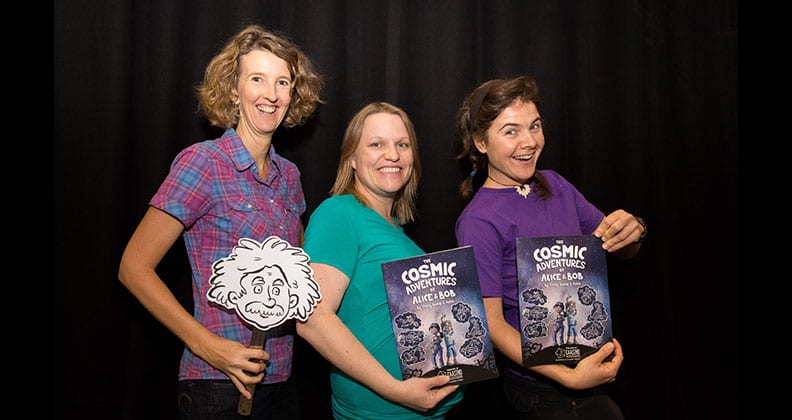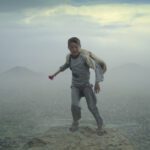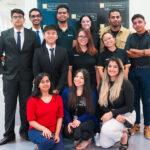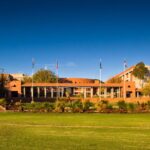Armed with a bit of imagination and a lot of curiosity duo Alice and Bob’s quest to answer the big cosmic questions is sure to inspire kids all over Australia thanks to local science communication adventurers.
The Cosmic Adventures of Alice & Bob tells the story of two young friends who utilise the science employed in appliances like microwaves and vacuum cleaners to create their own interstellar mode of transport to get them to their weekly hockey game.
The comic book is currently hitting classrooms all over Australia free of charge as part of an outreach activity for the ARC Centre of Excellence for All-Sky Astrophysics (CAASTRO).
CAASTRO Education and Outreach Manager Dr Wiebke Ebeling, who is based at the Curtin Institute of Radio Astronomy, says CAASTRO had done a lot of work previously engaging teenagers and more educated audiences and they wanted to target a slightly younger audience.
“Kids are like sponges, you tell them something interesting or show them gadgets and you have them on your side but they don’t always retain those traits as they get older,” she says.
“Our brief was to help kids maintain their curiosity and this have-a-go mentality so we set about creating a book that would do that and taught readers about astronomy at the same time.”
Ebeling engaged Perth-based children’s author and science writer Cristy Burne and quantum physicist and illustrator Aska, and together they devised the story of Alice and Bob.
Burne says she and Aska had a few false starts and worked on different ideas until they settled on the final narrative featuring inquisitive characters whose nature aligned with CAASTRO’s overarching vision of ‘big questions and innovative solutions’.
“We also included small stories about real life people – for example Percy Spencer and Jamie Link – who made ground-breaking discoveries by mistake or through some misfortune, so we wanted to convey the idea that failure is part of the process”, Burne says.
“In the book, stuff goes wrong for Alice and Bob. They go through hard times and happy times, much like in real life,” she says.
“You can’t just invent something and expect it is going to be smooth sailing and you are going to end up winning the Nobel Prize.
“I think kids are scared to fail. If you fail a test or you make a mistake it is seen as a negative thing but that is how we learn.
“You make a mistake and you try it again and do it differently and make another mistake and so on.”
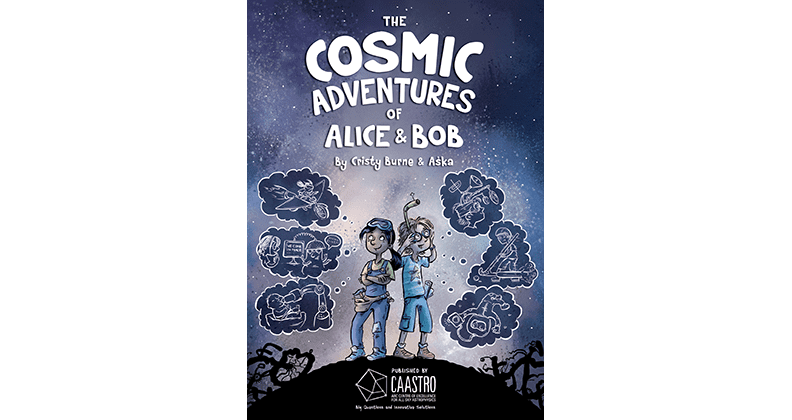
Burne says Alice and Bob are not necessarily clever kids but they are curious as well as being a bit goofy.
“We adapted that quote from Albert Einstein that Alice and Bob ‘have no special talent but they are passionately curious’.
“So they’re not gifted children that have come out of the womb knowing rocket science. They are just interested and they give things a go, that is what we want kids to take away from this book.”
The creators finished the book with snapshots of real astronomy projects and citizen science ventures including the WA-based Murchison Widefield Array and Square Kilometre Array.
“We are in the coolest place in the universe right now for doing astronomy and that means there will be jobs. The kids who are reading this book are the kids who, in 20 years, may be working on these projects or training to become astronauts to go to Mars,” Burne says.
Ebeling says kids should consider working in astronomy when they are older as the skills learned in the field are quite versatile.
“Astronomy has this huge wow factor, you have these beautiful images and these stories about places that are billions of light years away,” she says.
“It captures the imagination quite a bit, so it is easy to attract people to astronomy and then once they retain that big picture excitement it equips them to have a lot of great skills.”
